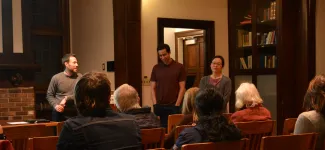“What happens when an ecologist, a civil engineer, and a structural engineer, walk into a bar…”
Michelle Tseng, Omar Swei, and Carlos Molina Hutt
The Leading Scholars’ Series is great for many reasons, but especially in the way it brings people together across disciplines, and generates dialogues on topics people didn’t know that they had in common.
This talk, titled From Bugs to Buildings: Parallels in Resilience and Adaptation, did move from bugs to buildings as it explored the two concepts of resilience and adaptation in natural and manmade environments. Michelle Tseng, in the departments of Zoology and Botany, introduced and defined the two with regards to ecosystems. Using bees as an example, she explained that the more diverse a community of bees, or the more different species populations there are in an area, the more adaptable the community is to changes in its environment, and therefore the more resilient it is.
As it turns out, this adaptability is also key to civil engineering work. Omar Swei walked the audience through a class project designed to highlight the necessities of adaptable construction. If, for example, you are planning to build a parking lot, it is important to consider cost alongside demand. You may want to argue that bigger is always better – however demand is something that is often unpredictable and changeable, and large scale construction projects can’t afford miscalculations. Thus, the solution is adaptability. Foundations that can withstand additional levels being added at a later date, for example. Recognizing that the future is uncertain and preparing for such uncertainties builds in resilience during construction.
Carlos Molina Hutt, a researcher in earthquake engineering, compared the objectives of seismic design to biological ecosystems. Successful seismic projects aim to reduce building failure, reduce consequences from failure, and reduce recovery time, just as more diverse communities of bees that experienced external changes to their environment had fewer lasting consequences and were therefore more resilient.
The parallels between these outwardly unrelated subjects offer insight into the possibilities from this kind of interdisciplinary research and knowledge sharing. With global issues such as climate change and the unpredictable future that it brings, these kinds of collaborations are essential, and these dialogues should continue to be encouraged.
by: Mairi Stirling Hill, Department of English Language and Literature, UBC @MairiJSHill
